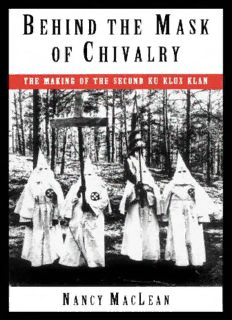
Behind the Mask of Chivalry: The Making of the Second Ku Klux Klan PDF
Preview Behind the Mask of Chivalry: The Making of the Second Ku Klux Klan
BEHIND THE MASK OF CHIVALRY This page intentionally left blank BEHIND THE MASK OF CHIVALRY The Making of the Second Ku Klux Klan NANCY MACLEAN OXFORD UNIVERSITY PRESS New York Oxford Oxford University Press Oxford New York Athens Auckland Bangkok Bombay Calcutta Cape Town Dar es Salaam Delhi Florence Hong Kong Istanbul Karachi Kuala Lumpur Madras Madrid Melbourne Mexico City Nairobi Paris Singapore Taipei Tokyo Toronto and associated companies in Berlin Ibadan Copyright © 1994 by Nancy MacLean First published in 1994 by Oxford University Press, Inc., 198 Madison Avenue, New York, New York 10016-4314 First issued as an Oxford University Press paperback, 1995 Oxford is a registered trademark of Oxford University Press All rights reserved. No part of this publication may be reproduced, stored in a retrieval system, or transmitted, in any form or by any means, electronic, mechanical, photocopying, recording, or otherwise, without the prior permission of Oxford University Press. Library of Congress Cataloging-in-Publication Data MacLean, Nancy. Behind the mask of chivalry : the making of the second Ku Klux Klan / Nancy MacLean. p. cm. Revision of thesis (doctoral)—University of Wisconsin-Madison. Includes bibliographical references and index. ISBN 0-19-507234-0 ISBN 0-19-509836-6 (Pbk.) 1. Ku Klux Klan (1915)—Georgia—Athens. 2. Athens (Ga.)—Race relations. 3. Athens (Ga.)—Social conditions. I. Title. HS2330.K63M225 1994 322.4'2'0975818—dc20 93-27548 8 10 9 Printed in the United States of America To my sister, Mary Anne, my parents, Jack and Ann, and the memory of my mother, Jeanne This page intentionally left blank Acknowledgments Sex has shielded me from some of the illusions and compulsions of my subjects. The fantasy of the "self-made man," for one, was never an option. So many people and institutions helped with the writing of this book in so many different ways that a full enumera- tion of their contributions would itself fill a book. But some de- serve special mention. Institutional support came from several sources. An Alice Free- man Palmer Fellowship, a Dissertation Fellowship from the Uni- versity of Wisconsin-Madison Graduate School, and a Charlotte Newcombe Doctoral Dissertation Fellowship gave me the time for research and writing. Archivists and staff members at many places aided the research process, particularly those at Special Collec- tions, the Russell Library, and the University Archives at the Uni- versity of Georgia Libraries in Athens; the Georgia Department of Archives and History in Atlanta,- the Atlanta Historical Society; the Library of Congress; the Robert W. Woodruff Library at Emory University; the Southern Historical Collection in Chapel Hill; and the William R. Perkins Library at Duke University. I owe special thanks to Dale Couch and Virginia Shadron for sharing with me their vast knowledge of the resources at the Georgia Department of Archives and History in Atlanta and their expertise in Southern history. Their generosity and good humor made research a pleasure. Other debts are more difficult to describe, since the more I re- flect on them the larger they loom. Singular thanks are due to Gerda Lerner. Her commitment to promoting women's history and viii Acknowledgments developing women's minds helped bring together and sustain a re- markable group of women in the Graduate Program in American Women's History at the University of Wisconsin-Madison. As a forum for thinking and learning about gender in history, it was exceptional—and hindsight teaches, precious. My greatest intellec- tual debt is to Linda Gordon, who was the advisor for my disserta- tion, which this book comes from. Her formidable intellect, politi- cal good sense, personal warmth, and devotion to her students enriched this book and its author in immeasurable ways. Gerda Lerner, Florencia Mallon, Tom McCormick, and Steve Stern taught me much and gave me invaluable advice at various stages of this work. For their incisive comments on parts of this work and for years of challenge, engagement, and solidarity—spiced with ample doses of much-needed diversion—Bob Buchanan, Maureen Fitzger- ald, Joyce Follet, and Leisa Meyer also deserve thanks. At North- western University, Jim Campbell, Jim Oakes, and Bob Wiebe gave me the benefit of their careful readings and thoughtful criticisms. Thanks also to Steve Hahn for encouragement and very helpful suggestions at two critical stages of this project. Others, outside the field of history, contributed in their own distinctive ways. Over the last decade, I have learned as much about the issues at stake in this work from activists and organizing as from scholars and research; political work schools an awareness of connections and a kind of rigor hard to acquire elsewhere. I owe a special debt to the people involved in the International Socialist tendency, whose ideas and activism taught me a great deal and whose commitment to a better world continues to inspire, even, where particular arguments no longer persuade. Finally, there are the family members to whom this book is dedicated. Their years of faithful support, their belief in me, and their love made it possi- ble for me to do this work. For this, and much more, I am deeply grateful. Contents Introduction xi PART I: CONTEXT AND MOTIVE 1 Mobilizing the Invisible Army 3 2 "Where Money Rules and Morals Rot": The Vise of Modernity 23 3 Men in the Middle: The Class Composition of the Klan 52 PART II: CONTENT AND PURPOSE 4 Reactionary Populism: The Politics of Class 77 5 "Cleaning Up" Morality: The Politics of Sex and Age 98 6 The Approaching Apocalypse: The Politics of Race 125 7 Paramilitary Paternalism: The Politics of Terror 149 PART III: MEANINGS 8 Conclusion: The Second Klan in Larger Perspective 177 Appendices 189 Abbreviations Used in Notes 193 Notes 197 Bibliography 255 Index 283
Description: